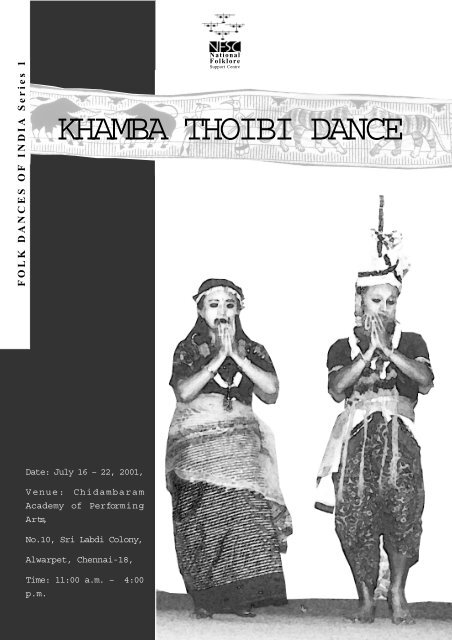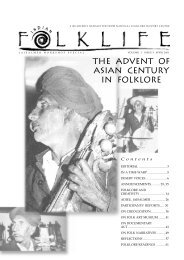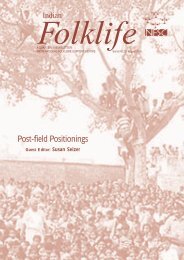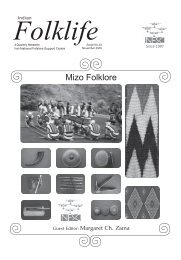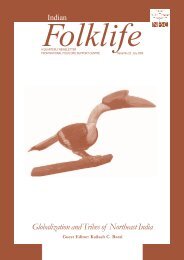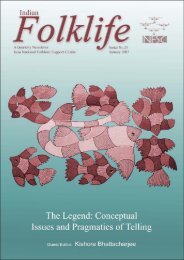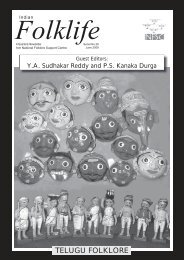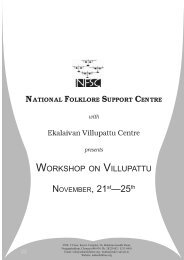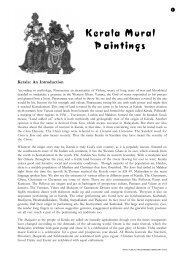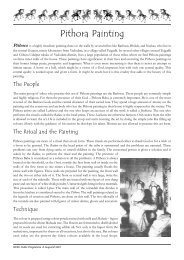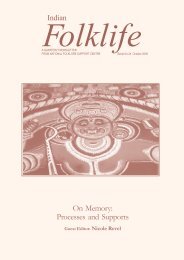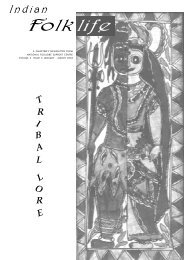KHAMBA THOIBI DANCE - Wiki - National Folklore Support Centre
KHAMBA THOIBI DANCE - Wiki - National Folklore Support Centre
KHAMBA THOIBI DANCE - Wiki - National Folklore Support Centre
You also want an ePaper? Increase the reach of your titles
YUMPU automatically turns print PDFs into web optimized ePapers that Google loves.
FOLK <strong>DANCE</strong>S OF INDIA Series 1<strong>National</strong><strong>Folklore</strong><strong>Support</strong> <strong>Centre</strong><strong>KHAMBA</strong> <strong>THOIBI</strong> <strong>DANCE</strong>Date: July 16 – 22, 2001,Venue: ChidambaramAcademy of PerformingArts,No.10, Sri Labdi Colony,Alwarpet, Chennai-18,Time: 11:00 a.m. – 4:00p.m.
<strong>KHAMBA</strong> <strong>THOIBI</strong> <strong>DANCE</strong>FOLK <strong>DANCE</strong>S OF INDIA Series 1HISTORY AND FOLKLORELocated at the centre, Manipur is encircled by Burma inthe East, Nagaland in the North, Cachar district of Assamin the West and Mizoram and the Chin hills of Burma inthe South. The language, dance, songs, dress, festivals,religious beliefs, agriculture, administration and martialarts of Manipur have contributed to Indian culture atlarge. The history of Manipur dates back as far as theStone Age and if early and later Brahmanical works areto be followed, this region was a part of Aryavarta.Agriculture is the main occupation of the people withpaddy as the major crop. About two thirds of thepopulation is concentrated on the small valleys andremaining one third is scattered in the hills. The valleyarea of Manipur is primarily inhabited by the Meiteipopulation, which according to oral tradition is composedof seven clans who speak a common language. Most ofthe other clans are endogamous but the Meiteis differfrom them, as they are exogamous. Marriage is generallyarranged between the parents and the idea of a bride pricedoes not exist. Again, the tribal practice of dormitoryinstitution for the young is absent in the Meitei clan.The present Manipuri language has evolved from theMeitei language and has its own script.The DanceIndia has been an absolute repository of dance forms for untold centuries and has given generations ofperformers to the world. All dances, be it classical or folk originates itself as a folk art in some form orthe other. If, dance is considered first as a representation and reinforcement of cultural pattern and onlysecondarily as an expression of individual emotion (Alan Lomax, Irmgard Bartenieff and ForrestinePaulay), folk dance can be defined in the same breathe. Every folk dance, when observed, seems to speakfor its culture and express their needs and concerns which is natural and original. Most of the classicaldances with all its refinement and art find their origin in a folk dance form. Much more than the grace andthe panache of the dancer, it is the tremendous enthusiasm and expressive body movements that is mostcaptivating in a folk dance. This oral tradition has been a part of life for the people residing in the tribalbelts of India and it will be only fair to give them credit for the origin of folk dances.Themes are very close to life comprising of religious rites and rituals, festivals, harvest, and relationships.They are composed of gestures, postures, movements and movement qualities most characteristic andmost essential to the activity of everyday and thus fundamental to cultural continuity. Folk dance in itsown rhythm, graceful yet rigorous body movements, soul captivating music and underlying lyrical themescan enchant anyone any day.THE LEGEND AND <strong>DANCE</strong> EPISODESSidaba, the Creator and whose name means immortal, is known to have a highly rhythmic movementaccording to the Manipur mythology. This is considered to be the basis of all Manipuri dances known forits graceful and rhythmic movements. But through the ages, dances have also come to be associated withreligious episodes from the mythology and performed with their applications to various stories and2
themes like, Lai Haroba, Ras Leela, Khabak (clapping), Ishri Cholom (song movement), Pung Cholom(drum movement) and Augri Hangel. Khamba and Thoibi dance narrates a tragic love story between acommoner Khamba and the beautiful princess Thoibi. The epic is in three episodes, Loi Kum (exile),Loikab (return), and the tragedy. The Manipuris however do not perform the tragic scene as they beliefthat a tragedy would befall on them.Khamba lives in Moirang, and belongs to the Moirang clan. The first episode starts with the death ofKhamba’s parents and he is left under the care of his maternal uncle who is not too eager to take up theresponsibility. He is not given the right education and becomes a milkman. But to the envy of his friendsand neighbours, he is an excellent sportsman. He earns his living by doing household chores in thehomes of the chieftains. It is during his work that he meets princess Thoibi and ultimately falls in love.Due to his brave deeds and extraordinary strength, he is recognized and appreciated by King Purembawho comes to learn the love affair between Khamba and Thoibi. Chinghuba, the chieftain and father ofThoibi, is asked by the King to give his daughter’s hand in marriage to Khamba. Chinghuba is notpleased with the order and awaits an opportunity to get rid of Khamba and marry off his daughter toChief Nongban of the Angom clan. Nongban is represented as a fool in the story and is a rival to Khamba.Chinghuba and Nongban try all ways and means to kill Khamba and somehow create a situation for KingPuremba to order Khamba to fight against a mad elephant. Khamba emerges triumphant but is seriouslyhurt. Much to the anger of the two conspirators, the king sends Thoibi to attend to Khamba till recovery.It is at this time that love flourishes even more and a highly artistic dance is performed by the duo beforethe temple of Shiva. This dance closes the first sequence.The second episode is the exile of Thoibi. After Khamba recovers, Thoibi returns home just to be rebukedby her father who thrashes her with a club. She feigns death for sometime but is later deported to Burmawhere the chieftain of Burma gives her protection. The chieftain develops fondness towards Thoibi andthis is disliked by his daughter and she ill-treats her. Meanwhile, there is a man-eating tiger on the prowlin the village Moirang who damages all cattle and crops. The king sends Khamba and Nongban to kill thetiger. Nongban dies in the process but Khamba turns out victorious. The King, pleased with the brave andgallant Khamba recalls Thoibi from her exile and gets her married to Khamba with great pomp and show.In this sequence Thoibi’s remarkable solo performance in the court of the Burmese Chief is worthmentioning.The last episode brings out the tragedy of the epic. Khamba and Thoibi leads a happy and blissful lifetogether but only for a brief time. Khamba’s faith in Thoibi is so strong that he would often flaunt it withhis friends. One day, his friends urge him to test Thoibi and prove that he is right. Khamba goes disguisedto Thoibi and abuses her with filthy language. Thoibi is enraged and not knowing that he is Khamba,pierces a spear through his heart and kills him. Through the years the last episode has been done awaywith in order to have a happy ending and also because of a superstitious belief that an equal tragedywould take place in the kingdom.Omang Lai Haraoba is the name of the forest God and during the months of May and June, the peoplecome out and worship the forest god with much fun and frolic. It is in this season that all lovers danceKhamba Thoibi in front of the forest god. This dance form has become soimportant to lovers that couples would spend a lot of time and energy to learnthe dance before the Lai Haraoba festival. The dancers feel that all their desiresand wishes would come true and that Lai Haraoba would bless all the lovers.The dance begins and ends with the dancers offering flowers and fruits to thedeity.Music and songThe entire narration is done through the song sung during the dance performanceand thus music and song form an integral part of the dance. The instrumentsused in this dance are: Pung (percussion): The pung has a wide edge on oneside and narrows down on the other side. It is covered with a transparent whitecloth when it is played. The player of pung wears a white dhoti, a white kurtaand a white cloth called Khurang Chet that is tied around the waist. A simplewhite cloth is tied around the head.33
FOLK <strong>DANCE</strong>S OF INDIA Series 1Pena (string instrument): The player is dressed exactly like Khamba. But only that he doesnot wear the feather on the turban and the back hanging from the turban is missing in theplayer’s attire.A man and a woman sing to the beat of the music. The man sings for Khamba and thewoman sings for Thoibi. The woman wears a white chadar (shawl) and phanek mapan naibi(sarong- like dress). The man wears a white dhoti and a white kurta. The lyrics of the songare in accordance with the dance movement. The movement of the body and the lyrics mustbe in perfect harmony. Thus the song and the dance cannot be performed without the other.There are absolutely no changes in the dance form. A good performance is judged accordingto the co-ordination of the dance with the narration done through songs.Bibliography and Online ResourcesProjesh Bannerji,1982, Aesthetics of Indian Folk Dance, Cosmo Publication, New DelhiRobin D. Tribhuwan, Preeti R. Tribhuwan,1999, Tribal Dances Of India, DiscoveryPublishing House, New Delhi.Projesh Bannerji,1944, Folk Dances of India, Kitabistan, Allahabad.Singh K.S., 1998, People of India- Manipur, Seagull Books, Calcutta.www.nic.in, www.boloji.com, www.assamcompany.comNFSC Endowment FundThrough our public programmes, our fieldwork experience and interactions with themedia, the staff and board of <strong>National</strong> <strong>Folklore</strong> <strong>Support</strong> <strong>Centre</strong> decided to create anendowment fund for making grants to disadvantaged Indian folk artists. Anendowment fund is created through donations and the principal amount remainsunspent. Recently a donor has contributed Rs.10,000 to create Professor K.S HaridasaBhat Memorial Endowment Fund at NFSC. The proceeds of this particular fund willbe utilised for making awards to deserving Kannada folk artists. Indian nationals areencouraged to donate for this endowment fund or for creation of new funds. Alldonations can be paid by cheque or DD in the name of <strong>National</strong> <strong>Folklore</strong> <strong>Support</strong><strong>Centre</strong>. For more information please contact Director, NFSC, Chennai.Artists: Smt Heisnam Birohini / Shri Louiebam Kenneth SinghaUrban life has lost community dancing. Whatever exists as urban partydancing is so soulless that it does not enhance sensitivity towards humaninteraction. Folk dances embedded in local contexts, social living andmythologies offer alternative possibilities for rediscovering spaces andgestures to energize our social life. With our successful ongoing series ofworkshops on visual arts traditions of India Series, we at <strong>National</strong> <strong>Folklore</strong><strong>Support</strong> <strong>Centre</strong> commence another series of workshops on folk dances ofIndia. Enrolled participants will be treated to lectures, demonstrations,interactive session with native folk dancers and comparative movementanalysis apart from the practical training. With a finely tuned but unobtrusivedance pedagogy one should be able to discover what it means to danceagain. The series begin with unknown dances of Northeastern India makingthe series unique and special, both for the novice and specialist.NFSC in collaboration with Chidambaram Academy of Performing Arts announces its first publicprogramme- Khamba Thoibi Dance workshop as part of its Folk Dances of India Series ------- For registrationcontact: Rola/Jasmine/Siva at NFSC, No.65, Fifth Cross Street, Rajalakshmi Nagar, Velachery, Chennai-600042 Ph: 2450553/2448589, E-mail: info@indianfolklore.org, Site: www.indianfolklore.org.Paper courtesy: Sankeshwaraa Papier (P) Ltd. #69, Royapettah High Road, I.O.A. Complex, GroundFloor, Shop # 27a & 28a, Chennai – 600 014. Phone : 8112994 / 995. Fax : 91-044-6258508.4


